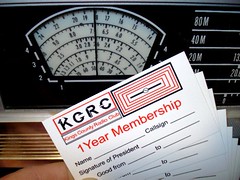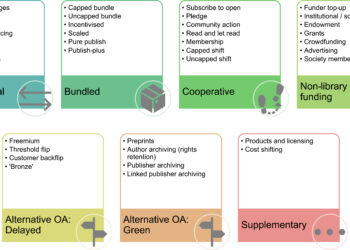Sometimes a business model hides in plain sight.
A while back I posted about the various business models available for scholarly communications. I was motivated to try to bring some clarity to a topic that often seems mysterious, with cries for “New business models! New business models!” ringing throughout the academy. My argument was that while there was much that is new in the way of business, there was little new in the matter of business models. Businesses have only a small number of ways to generate revenue, and this doesn’t vary whether a scholarly publisher works in print or digital form. I developed these thoughts further in a presentation at the recent AAUP conference.
Staring me in the face was a fifth revenue model, that of the membership society, which has a long and venerable history in scholarly communications.
To back up a minute, here are the four models of my previous post:
1. User-pays. This is the model for traditional publishing, where readers pay for access to content. Step into a bookstore, pick up a volume and head to the cash register, and you are in the user-pays world. For many people reading scholarly material, there is a proxy — a university library — that pays for access on behalf of end-users.
2. Author-pays. This is the model pioneered by BioMed Central and now used by such organizations as the Public Library of Science, SAGE Open, and in new services by for-profit and not-for-profit organizations alike: John Wiley, AIP, BMJ, among others. This model is not to be confused with vanity publishing, as most of the new author-pays services involve rigorous peer review. Most author-pays services are open access.
3. Marketing services. The best-known marketing service is advertising. A publisher working with marketing services uses content to attract an audience. That audience is then packaged and “sold” to marketers. Those ads for orthopaedic devices in medical journals are a case in point.
4. Institutional support. Sometimes a sponsoring body simply pays for the publishing process. Institutional support is found everywhere in scholarly communications, from subsidies for university presses to publish monographs in highly specialized areas to the underwriting of institutional repositories resident in libraries.
So, four sources of revenue, which can be combined in a variety of ways. For more context, I refer you to the original post.
A membership community potentially has a different way of conducting its affairs. A group of people working in the same area (the area does not have to be academic research) might decide that they have a shared interest in publishing some of their material. They thus pool their resources, appoint individuals to oversee the publications, establish policies, and make the material available to fellow members of the community. The revenue model derives from the membership fee: Become a member of this professional society and, as a member benefit, you will get the society’s publications for free (that is, as an aspect of the cost of membership). Members can also submit materials for publication, creating a network of reciprocal arrangements.
At first glance, the membership model appears to be a form of user-pays publishing, as access to content requires a fee. But this model differs from the traditional one in its reciprocal nature: One fee provides access to both content (like the user-pays model) and to the publishing process itself (like the author-pays model). It’s thus very much a community model of publishing, where membership has its privileges.
The membership model has for years been the primary means of financing many areas of scholarly communications. Over time it has evolved, of course; few professional societies use this model without also employing some of the other four models as well. For example, while a publication might be free to members, access to non-members, often through libraries, may carry a fee (the user-pays model once again); and some societies have long used a limited form of author-pays by levying page charges. Or, if the particular area of publishing supported it, a society publication might get involved in marketing services, using advertising revenue to shoulder some of the costs of publication and perhaps even to support other aspects of the society’s agenda such as membership education.
Some membership societies are struggling with their business models at this time, of course, and the reason for it is that many people working in the field no longer believe that membership is worth the dues. Part of the reason for this is that the primary membership benefit for many societies — access to the content of the societies’ publications–is being undercut by the near-ubiquity of access through academic libraries. Thus an individual in the print era may not have questioned the need to pay dues to a professional society, but when the same content is available digitally from an academic library — and by remote access, enabling the researcher to review the material at home in his or her pajamas — the appeal of membership declines. (The Pajama Factor is one of the most disruptive forces in scholarly communications today.) Similarly, a society that makes its content available through open access may experience declining interest among its members to continue paying membership dues. What, after all, is the point of being in a community unless it serves to define those who are outside it?
All revenue models have strengths and weaknesses, and this is true of the community-based membership model as well. Professional societies have trouble setting dues high enough to support all of the community’s functions, which puts pressure on the publishing group to find revenue elsewhere. That “elsewhere” is typically academic libraries, which puts professional societies in the same camp as commercial publishers, who look to library revenue (user-pays) to support their programs. This in turn accounts for why so many societies make arrangements with large publishers: they have the same economic interests in the user-pays world. Nor is a closed information system for a professional society — where the publications are only made available to members — acceptable either, as there are researchers in adjacent fields who need access to the content, though not necessarily on such a regular basis as to warrant paying for membership. The membership model thus rarely or never exists on its own but is hybridized with one of the four other economic models.
So we have five revenue models to work with: user-pays, author-pays, marketing services, institutional support, and the membership model. These models apply whether one is working in print or digital material, whether the products and services are based in text, video, animations, or cortical implants; and they apply to open access publishing. There is nothing exotic or newfangled about business models, which makes the chorus clamoring for new business models irrelevant. As a practical matter, it is unlikely that any publication will work with one revenue model alone. Hybridization is thus the norm, and thoughtful management, as always, is the key to success.
Discussion
11 Thoughts on "The Membership Business Model for Scholarly Communications"
Like other scholarly communication business models today, the membership model has its challenges. In recent years, scholarly societies have typically relied on 3 major revenue sources to support their activities–dues, publications, and professional conferences. The mix has varied has varied from society to society. Some, particularly those in science and medicine, have been able to develop exceptionally strong publishing programs, while larger societies, whatever the field, have been able to generate significant revenues from conferences and meetings. Smaller societies, particularly those in the humanities, have had a harder time generating revenues from these two sources, forcing them to rely more heavily on dues–which are seldom set at a level sufficient to fully cover the cost of the society’s membership benefits program.
Societies that adopt the OA model are immediately faced with the challenge of either finding a way to make their OA publishing program self-supporting, e.g. by charging relatively high author fees, or making up the difference from other existing sources, i.e., dues and conference fees, or coming up with new revenue sources altogether. No one, so far as I know, has come up with a perfect solution to this problem. That has not stopped, and probably will not stop, more societies from adopting an OA publishing model, but it means that we have not yet fully come to grips with the longer-term implications of OA on either scholarly communication or scholarly societies. If necessity is the mother of invention, many scholarly societies are badly in need of her assistance today.
It’s a truism to say that communication has sped up, and instant response is now the norm; what’s surprising to me (as one who works in scholarly books) is that journals haven’t (to my knowledge) have made the centralization of a follow-up discourse (you might call it a “comment thread”) on their publications a feature of both their publication and their membership model. Why not members-only comment areas, so that the public can have access to peer-reviewed and edited content, and there is a members-only sandbox which springboards from the articles into general–and high-level discussion. An author-meets-critics session for every article would offer increased opportunity for communication and also reputation-building–a young scholar could certainly benefit from showing wisdom and perception in criticism and discussion, especially given the increasing level of online interaction with students.
Strictly from a business-model perspective, this would offer both a way to “corner” more of the serious discourse on a topic (or within a subfield, or with a given methodology), making membership in a society essential for scholars. Additionally, opportunities for levels of membership (and the psychosocial rewards of status) can drive increased usage of such discussion areas.
I refer Mr. or Ms. Dingbat (Professor Dingbat?) to the emerging world of social reading. There was a great presentation of one such platform at the recent AAUP conference in Baltimore. The presenter was Bob Stein; his new company is SocialBook. Dr. Dingbat’s vision is coming soon to a text near you.
Ah, yes, I’ve seen some of Bob Stein’s writings (linked here, mostly, and at if:book), and it seems that he’s coming at it with a technology to bring many of the social virtues of internet interaction to a codex-length work. But it seems to me that societies are missing out on an opportunity to take what they already have –not merely a supply of content but a formalized membership (shall we call it a social network?)–and merge it with the now ubiquitous and comfortable formats of comment, response, recommendation, link-forwarding, etc.
It may be a healthy thing to have discussion of scholarly work widely distributed as it is now (I’m thinking of comments at scholars’ blogs like Crooked Timber and Marginal Revolution, as well as the myriad twitter feeds and, of course the invisible network of “have you seen X’s new article on ABC?” emails), but surely there is something to be said for the fact that the people who are most likely to read and to respond to an article were in their society five or ten or fifteen years ago, and are now, as you point out, less likely to be so.
For about 10 years, my journals have provided an eLetter response to all articles, which is intended to function as you describe. We have received and published maybe a dozen comments from readers in that time across five titles. It seems that very few researchers are willing to put their comments online for all to see. I think this reflects why reviewers remain anonymous for most journals. From my expereince, it’s difficult to expect sufficient participation to make this a succesful business model.
Have you found any societies doing this successfully? I work in society publishing and am hearing that members do not have the time to spend on any writing that does not advance their careers.
These sorts of forums have been regularly offered, but only rarely used. PLoS releases data sets of the numbers of article comments and ratings that they receive and they’re pretty uncommon (and many comments are things like the author updating their address, or even worse, “Nice article Bob” sorts of comments).
The reasons for this are many, and the general lack of online discussion and participation in the research community is something we discuss at the Scholarly Kitchen frequently. Some of the main factors are time, or the lack thereof (researchers are pressed for time, so any activity without a direct career reward is not worth the effort) and fear (putting your name on a public and permanent criticism of another’s work is worrisome when that author may sit on your next grant, hiring or tenure review committee).
In the abstract, it’s a great idea, but so far in reality, getting researchers to buy in has failed.
Somewhat akin to the membership model but having an even longer pedigree is the subscription model that was common in 18th-century England. This was not subscription in the sense we know from journal publishing today. Rather, it was a scheme whereby a publisher would float a proposal for a book with booksellers and/or a group of individual “subscribers” and then only proceed with publication of the book if a sufficient number of commitments for orders had been solicited up front. An idea like this was broached recently by Eric Hellman when he suggested that library acquisitions collectives organize themselves along these lines. This would take “patron-driven acquisitions” one step further, in that no book would even be produced unless the collective came forward with an order for a minimum number of copies. This approach would remove the element of speculation from the system and be more economically efficient in many respects, but it might also lead to some downsides, like pioneering works not being published because they are ahead of their time and the “subscribers” would not be willing to bet on ideas too far out in front of what Tom Kuhn called the reigning paradigms. I explore the possibilities of a subscription model in this sense further in my essay titled “Back to the Future” (a revision of my Charleston 2010 talk) now accessible here: http://www.psupress.org/news/SandyThatchersWritings.html.
Joe,
I’ve appreciated your perspective on business models in scholarly publishing for many years. I focus on the broader B2B publishing market, but with my current specialization in healthcare information I straddle B2B, scholarly, and B2C markets.
My colleagues at InfoCommerce Group developed a business model taxonomy for the business to business data publishing segment, but the revenue model options apply equally well to scholarly publishing and other publishing market segments. The taxonomy framework can be downloaded for free here: http://infocommercegroup.com/taxonomies/.
I’d be interested in hearing feedback on the business model framework from the Scholarly Kitchen readership. (You’ll note that we haven’t created a separate healthcare industry taxonomy, primarily because the general framework applies there, too.)




